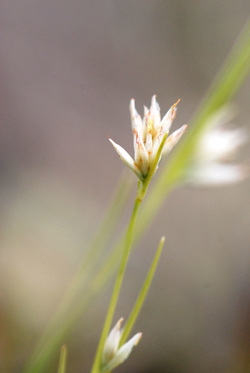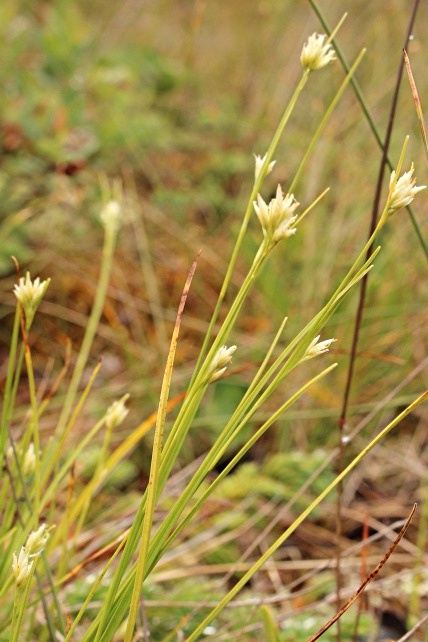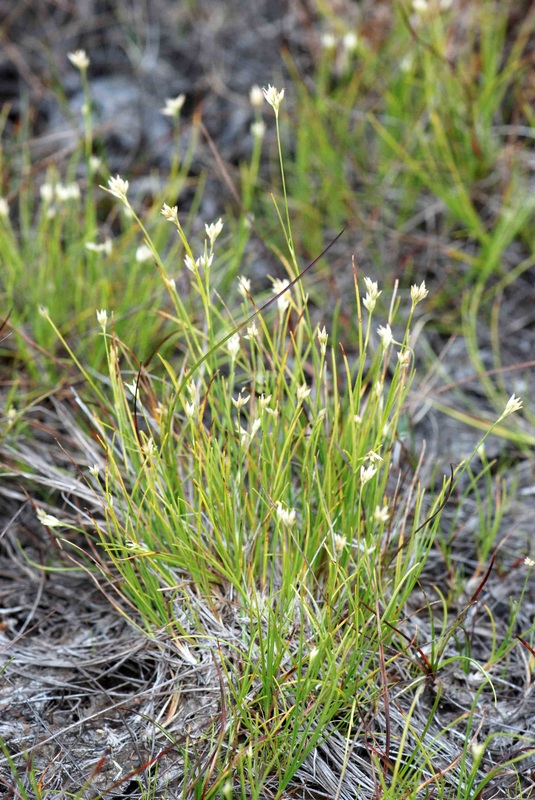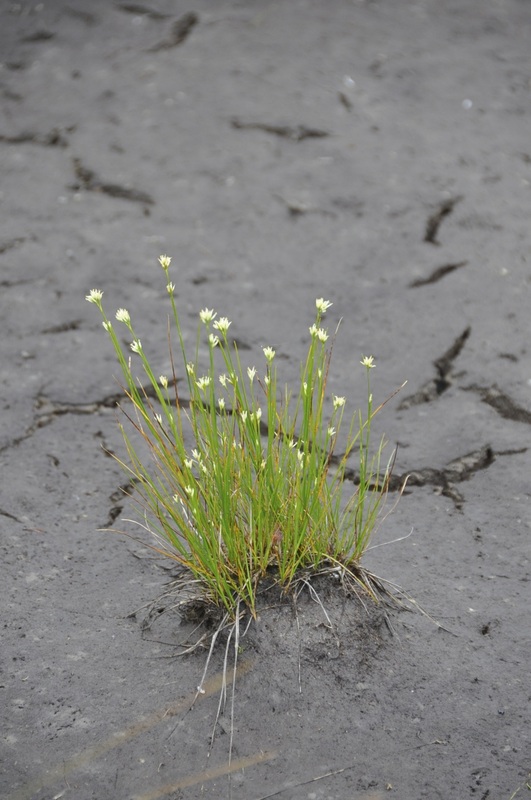White beak-rush, whitebeak sedge • Rhynchospora alba
{Rhynchospora = beaked seed; alba = white}
|
White beak-rush growing in boggy habitats. Photos by Nancy Shackelford (bottom left), Kira Hoffman (right), and Kelly Fretwell.
|
Identification
White beak-rush is actually a sedge species, despite its misleading name. It is a perennial species and grows in dense tufts. It has thin, triangular stems with numerous leaves. The leaves are narrow (1 mm wide or less) and are generally shorter than the stems. The lower leaves are reduced, and vary in cross-section from flat or folded to triangular. The inflorescence takes the form of small spikelets grouped in 1-3 clusters to 1.5 cm wide. These clusters appear as heads, and the terminal cluster is larger than the rest. There may or may not be stalked lateral clusters. The spikes start off white, then turn light brown with white or pink tinges.
Habitat & Range
White beak-rush grows in bogs and fens with wet peaty or sandy soil and full sun. It is a common species found from low to middle elevations west of the Coast-Cascade mountains, and infrequently in south-central BC. Its is a circumpolar species; it is found across much of North America and in the West Indies and Eurasia.
Similar Species
Tufted clubrush (Trichophorum cespitosum) can appear similar to white beak-rush when neither plant is in flower.
Intriguing Info
This is the only Rhynchospora species found in in coastal BC, and one of only two in BC (brown beak-rush is a red-listed species found in southeast BC). This genus tends to be found in warmer climates.
iNaturalist
https://www.inaturalist.org/taxa/57862-Rhynchospora-alba
White beak-rush is actually a sedge species, despite its misleading name. It is a perennial species and grows in dense tufts. It has thin, triangular stems with numerous leaves. The leaves are narrow (1 mm wide or less) and are generally shorter than the stems. The lower leaves are reduced, and vary in cross-section from flat or folded to triangular. The inflorescence takes the form of small spikelets grouped in 1-3 clusters to 1.5 cm wide. These clusters appear as heads, and the terminal cluster is larger than the rest. There may or may not be stalked lateral clusters. The spikes start off white, then turn light brown with white or pink tinges.
Habitat & Range
White beak-rush grows in bogs and fens with wet peaty or sandy soil and full sun. It is a common species found from low to middle elevations west of the Coast-Cascade mountains, and infrequently in south-central BC. Its is a circumpolar species; it is found across much of North America and in the West Indies and Eurasia.
Similar Species
Tufted clubrush (Trichophorum cespitosum) can appear similar to white beak-rush when neither plant is in flower.
Intriguing Info
This is the only Rhynchospora species found in in coastal BC, and one of only two in BC (brown beak-rush is a red-listed species found in southeast BC). This genus tends to be found in warmer climates.
iNaturalist
https://www.inaturalist.org/taxa/57862-Rhynchospora-alba
References
Pojar, J. and MacKinnon, A. (1994). Plants of Coastal British Columbia. Vancouver, BC: Lone Pine Publishing. P. 408.
Rhynchospora alba (L.) Vahl. In Klinkenberg, Brian. (Ed.). E-Flora BC: Electronic Atlas of the Plants of British Columbia. Lab for Advanced Spatial Analysis, Department of Geography, University of British Columbia, Vancouver. Accessed 11/09/2013.
Authors and editors of page
Kelly Fretwell and Brian Starzomski (2013).
Pojar, J. and MacKinnon, A. (1994). Plants of Coastal British Columbia. Vancouver, BC: Lone Pine Publishing. P. 408.
Rhynchospora alba (L.) Vahl. In Klinkenberg, Brian. (Ed.). E-Flora BC: Electronic Atlas of the Plants of British Columbia. Lab for Advanced Spatial Analysis, Department of Geography, University of British Columbia, Vancouver. Accessed 11/09/2013.
Authors and editors of page
Kelly Fretwell and Brian Starzomski (2013).








